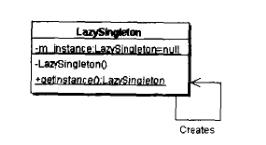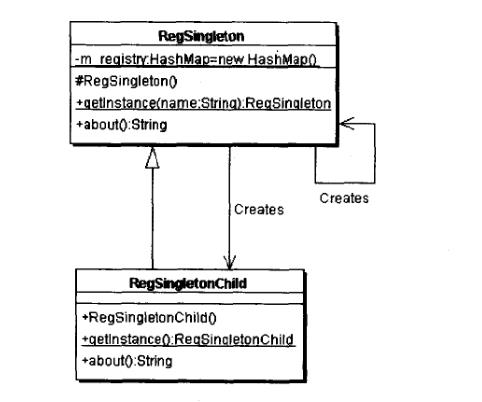[Js-设计模式]单例模式(饿汉,懒汉,登记式)
Posted Js_zero
tags:
篇首语:本文由小常识网(cha138.com)小编为大家整理,主要介绍了[Js-设计模式]单例模式(饿汉,懒汉,登记式)相关的知识,希望对你有一定的参考价值。
·单例模式的特点:
1. 单例类只能有一个实例。
2. 单例类必须自己创建自己的唯一实例。
3. 单例类必须给所有其他对象提供这一实例。
·各种单例模式的特点:
·懒汉式是延时加载,在需要的时候才创建对象,避免内存浪费,但存在线程安全问题。
·饿汉式线程安全,类一加载就实例化对象,所以要提前占用系统资源。
·登记式单例模式克服了饿汉以及懒汉单例的不可继承问题,其子类在登记时才被创建,并且子类的实例化方式只能是饿汉式。
·各种单例模式的类图:
·饿汉式单例模式

·懒汉式单例模式:

·登记式单例模式:

· 各种单例模式的实现(Java):
1 package com.neu.core; 2 3 /** 4 * Only once instance of the class may be created during the execution of any 5 * given program. Instances of this class should be acquired through the 6 * getInstance() method. Notice that there are no public constructors for this 7 * class. 8 */ 9 public class EagerSingleton { 10 private static final EagerSingleton m_instance = new EagerSingleton(); 11 12 protected EagerSingleton() { } 13 14 public static EagerSingleton getInstance() { 15 return m_instance; 16 } 17 }
=======================神奇的分割线==========================
1 package com.neu.core; 2 3 /** 4 * Only once instance of the class may be created during the execution of any 5 * given program. Instances of this class should be acquired through the 6 * getInstance() method. Notice that there are no public constructors for this 7 * class. 8 */ 9 public class LazySingleton { 10 private static LazySingleton m_instance = null; 11 12 private LazySingleton() { } 13 14 synchronized public static LazySingleton getInstance() { 15 if (m_instance == null) { 16 m_instance = new LazySingleton(); 17 } 18 return m_instance; 19 } 20 }
=======================神奇的分割线==========================
1 package com.neu.core; 2 3 import java.util.HashMap; 4 5 public class RegSingleton { 6 static private HashMap m_registry = new HashMap(); 7 8 static { 9 RegSingleton x = new RegSingleton(); 10 m_registry.put(x.getClass().getName(), x); 11 } 12 13 protected RegSingleton() { 14 } 15 16 static public RegSingleton getInstance(String name) { 17 if (name == null) { 18 name = "com.neu.core.RegSingleton"; 19 } 20 21 // System.out.println("From RegSingleton: requesting for " + name ); 22 23 if (m_registry.get(name) == null) { 24 try { 25 m_registry.put(name, Class.forName(name).newInstance()); 26 } catch (Exception e) { 27 e.printStackTrace(); 28 } 29 } 30 return (RegSingleton) (m_registry.get(name)); 31 } 32 33 public String about() { 34 return "Hello, I am RegSingleton."; 35 } 36 37 }
1 package com.neu.core; 2 3 /** 4 * This class is a subclass of RegSingleton 5 */ 6 public class RegSingletonChild extends RegSingleton { 7 public RegSingletonChild() { 8 } 9 10 static public RegSingletonChild getInstance() { 11 return (RegSingletonChild) RegSingleton.getInstance("com.javapatterns.singleton.demos.RegSingletonChild"); 12 } 13 14 public String about() { 15 return "Hello, I am RegSingletonChild."; 16 } 17 18 }
以上是关于[Js-设计模式]单例模式(饿汉,懒汉,登记式)的主要内容,如果未能解决你的问题,请参考以下文章